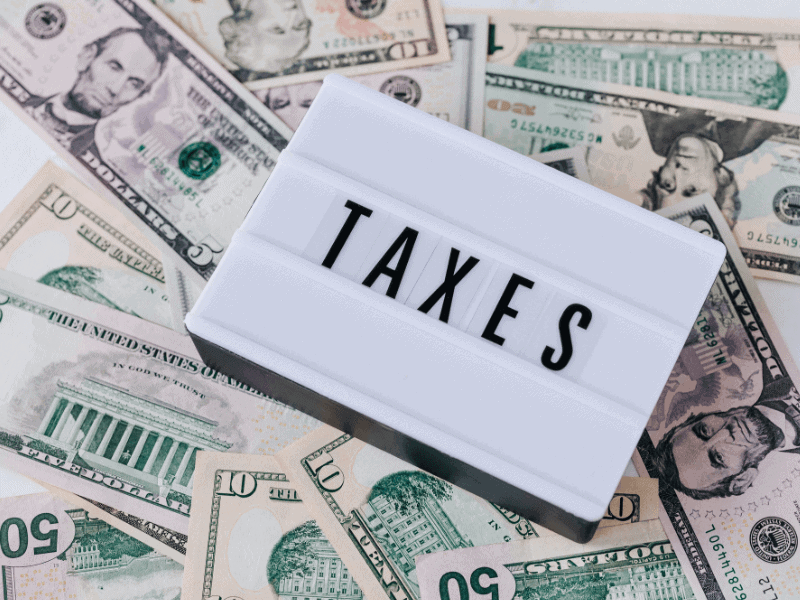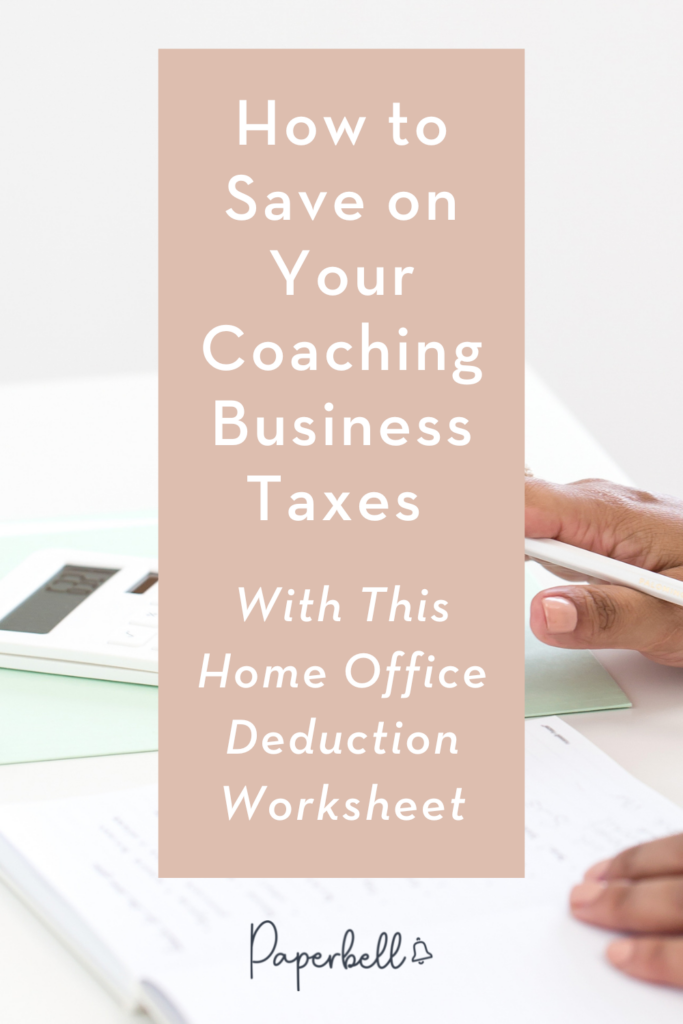
If becoming a coach is your calling, there’s nothing that compares to the feeling of working with your dream clients and helping them become the best version of themselves. No other job in the world can fulfill you in the same way!
You’ll get to enjoy several benefits as a self-employed coach, but you’ll also have to deal with the complication of income tax. Because you no longer have a boss, you’re fully responsible for setting aside money to pay your taxes.
So, if you’re wondering, “How much should I set aside for taxes as a coach?”, keep reading to find out how you can figure out that exact number.
5 Quick Tips for Managing Small Business Taxes
When figuring out how much money to set aside for taxes, all the information out there can get overwhelming. Here are five simple tips to help you stay on top of things.
1. Estimate and Track Your Income
Keeping track of your income is the best place to start when calculate your estimated taxes. You can calculate your annual income based on your average monthly earnings. Keeping track of your income throughout the year will help you ensure you have an accurate figure for tax purposes.
2. Determine Your Tax Rate
Understand your tax obligations by identifying your tax rate. Self-employed individuals often need to pay both income tax and self-employment tax. Consult a tax professional or use a tax calculator to determine your tax liability.
3. Create a Separate Tax Savings Account
Open a separate bank account dedicated solely to saving money for taxes. Set up automatic transfers from your business account to this tax savings account regularly. This ensures that you consistently set aside funds for your tax obligations.
4. Set a Realistic Savings Goal
Once you know your estimated tax rate, you can determine the percentage of your income you need to keep for taxes .A common recommendation is to save between 25% to 30% of your income. Adjust this percentage based on your specific tax situation and consult with a tax advisor for personalized advice.
5. Regularly Review and Adjust
Regularly review your income, expenses, and tax obligations to ensure that you’re setting aside an appropriate amount for your estimated tax payments. If your income fluctuates or your business expenses change, adjust your savings strategy accordingly. It’s better to save more than necessary rather than face a tax bill you can’t afford.
Remember, it’s crucial to consult with a qualified tax professional or accountant who can provide personalized advice based on your specific financial situation and applicable tax laws. They can help you develop a comprehensive tax strategy and ensure you’re saving the right amount for your tax obligations.
How Much Should I Set Aside For Taxes? Things to Consider
Before you can figure out how much you’ll owe in taxes, there are a few details you need to consider.
If you’ve had a job before you decided to start your coaching business, you’ll be familiar with income taxes. At the federal level, everyone in the US pays a certain percentage of their income for income taxes. The exact percentage will vary depending on which tax bracket you’re in.
For example, the federal tax brackets for singles in 2023 are the following:
| Taxable Income | Tax Bracket |
| $11,000 or under | 10% |
| Between $11,000 and $44,725 | Flat rate of $1,100 plus 12% of the excess over $11,000 |
| Between $44,725 and $95,375 | Flat rate of $5,147 plus 22% of the excess over $44,725 |
| Between $95,375 and $182,100 | Flat rate of $16,290 plus 24% of the excess over $95,375 |
| Between $182,100 and $231,250 | Flat rate of $37,104 plus 32% of the excess over $182,100 |
| Between $231,250 and $578,1259 | Flat rate of $52,832 plus 35% of the excess over $231,250 |
| Over $578,125 | Flat rate of $174,238.25 plus 37% of the excess over $578,125 |
You’ll go through the same process if you have state taxes to pay, too. Some states don’t have income taxes, such as:
- Alaska
- Nevada
- Florida
- New Hampshire
- Tennessee
- South Dakota
- Texas
- Washington
- Wyoming
However, income tax applies to people who have traditional jobs. Their employers also pay taxes as a business.
Self-employed coaches will need to take other taxes into account in addition to their income tax because you don’t have an employer paying those taxes for you.
You’ll see these taxes referred to as the self-employment tax or SE tax.
So why are you paying this tax, exactly? Where does the money go?
Two taxes make up this additional obligation:
Social security and Medicare taxes.
If you had a paycheck from an employer, this tax would show up on your pay stub as the FICA tax, which stands for Federal Insurance Contributions Act. You pay half of this tax while your employer contributes the other half.
You’ll be considered self-employed by the IRS if you’re a coach (unless you offer coaching services on behalf of your employer), but also if you’re:
- Freelancing
- Working as an independent contractor
- Have a sole proprietorship or business partnership
Together, the social security and Medicare taxes total 15.3% of your taxable income. However, 12.4% of that tax comes from social security, which won’t necessarily apply to your entire business income.
Self-employed individuals only pay Social Security taxes on their ‘wage base.’ Any income you generate over that amount is not taxable.
The exact wage base varies annually, but in 2023, it’s $147,000.
On the other hand, the remaining Medicare tax (2.9%) applies to your entire self-employment income. You’ll also have an additional Medicare tax of 0.9% if you have income above certain thresholds (depending on your filing status).
Unlike people with regular jobs, self-employed coaches must pay their tax bill using quarterly tax payments.
Finally, there’s the last consideration before you panic about all your money vanishing in front of you — you can drastically reduce the amount of income you pay tax on! Without tax 1099 nec write offs, you’d be taxing your income twice. You can read more about how to write off your expenses in this post.
How Much Should You Save for Taxes As a Coach: The Calculation

Okay, so now you have all the information about your tax obligations. So how much money should you set aside for taxes on your coaching business?
First, let’s calculate the amount of income tax you’ll need to pay. You’ll need to perform this calculation at the federal and state level. Making these calculations will help you manage your budget, especially if you’re in the first year of your business.
You’ll find the complete list of tax brackets for 2023 on the AARP website.
Start by finding your total business income and subtracting all your business expenses. For example, if your gross income from your coaching packages was $100,000, but you also spent $15,000, your net earnings would be $85,000.
Talk to your bookkeeper if you’re unsure what your expenses were for the year.
Next, calculate the amount of taxes based on your filing status and your tax bracket. With a net income of $85,000, you’d fall in the “Between $41,776 and $89,075” bracket as a single person.
Here’s how you calculate income tax for that amount:
(Flat rate of $4,807.50) + ((85,000 – 41,775) x 0.22)
In total, you’d have $43,225 of your income that needs to be paid at a 22% rate. That means you’d pay a total of $14,317 in income tax.
Next, let’s calculate how much self-employment tax you’ll need to pay.
Bring back your net income from the previous calculation.
Are your net earnings above or below the Social Security wage base? If they’re above, remember you won’t pay the Social Security tax (12.4%) for all the income that exceeds that amount.
If it’s below, here’s the calculation you can make:
(Net income) x .9235 = Taxable income for self-employment taxes
If you’re wondering where the .9235 comes from, remember that employers pay a 7.65% portion of your FICA taxes. You can deduct that percentage from your net revenue as a self-employed coach.
Next, you can multiply your income by the self-employment tax rate, which is 15.3%:
(Taxable income) x .153 = Taxes you owe for self-employment
If you use a single formula, here’s what it would look like:
((Net income) x .9235) x .153 = Self-employment taxes
Let’s plug in some numbers for a coach who netted an income of $85,000:
((85,000) x .9235) x .153 = $12,010.12
You’d pay $12,010 for your self-employment tax.
But what if your net earnings are over the Social Security wage base? If that’s the case, you’ll need to add an extra step in the calculation by separating both taxes.
For example, let’s say you made a net income of $200,000. After calculating how much income you should pay tax on, you get $184,700.
Because the Social Security wage base is $147,000 in 2022, you’ll pay the following in Social Security taxes:
147,000 x 0.124 = $18,228
But now you need to add what you’ll pay for Medicare , which is calculated like this:
(Taxable income) x 0.029 = Medicare taxes
With a taxable income of $184,700, here’s what this looks like:
184,700 x 0.029 = $5,356.3
Now all that’s left to do is add your Medicare and Social Security taxes together:
5,356 + 18,228 = $23,584
And you have your final self-employed tax number!
Keep in mind that the total amount of taxes you owe will depend on your tax deductions. You can deduct a portion of your self-employment tax from your net income before you calculate your income taxes — in addition to a plethora of other deductions!
If you’re not sure how much to set aside, a good rule of thumb is to keep about a third of your income for taxes (33%). However, if you live in a state with a higher income tax rate, such as California or New Jersey, consider keeping it closer to 40%.
It’s always better to overestimate the amount you owe, than underestimate it and find yourself caught short when you need to pay your tax bill.
Where to Save the Money You Set Aside for Taxes
As you’re keeping money aside from your coaching business revenue, what’s the best way to store that money?
Firstly, don’t invest your tax savings. Investing will make it difficult to access your funds quickly (and there’s a risk you’ll lose too much to pay what you owe).
To remove the temptation to dip into your savings, open a separate bank account. A business savings account would be a great option to keep that tax money safe until you need it. Make it a habit to transfer money into that account every time you receive payment from a coaching client — or set up automatic bank transfers if that’s what you prefer.
As your income as a coach may not be fixed every month, it’s best to keep money aside in a separate account so it’s there when you need it.
When Will You Have to Pay Your Taxes as a Coach
People with regular jobs only pay tax during tax season. But it’s different for businesses and self-employed people. As a coach, you’ll need to make payments every quarter.
You still file your taxes once per year. However, you’ll need to keep in mind you will make quarterly estimated tax payments, based on your earnings.
This won’t apply if you’re in your first year of business because you won’t have filed an annual return yet.
If you’re a coach living and working abroad, the tax laws can be different and sometimes confusing. In such cases, you might find it beneficial to file Form 4868. This form allows for an automatic extension of time to file your U.S. individual income tax return.
How Do You Make Your Tax Payments as a Self-Employed Coach?
You can make your quarterly tax payments to the IRS online, or through their app. If you like to keep things old school, you can fill out the 1040 ES form and mail it to the IRS.
If you don’t make your estimated quarterly tax payments on time, you could face a fine of up to 3% of the amount you owe.
Simplify Tax Season by Streamlining Your Coaching Business
Tax season is already complicated enough as it is. You shouldn’t have to overcomplicate the rest of your coaching business!
So now you know the answer to your question, “How much should I set aside for taxes?”, the next tax season should be easier than ever before”
Did you know that you can automate the admin side of your coaching business with Paperbell? This tool was designed with coaches in mind and lets you easily take payments, automate email follow-ups, create custom booking calendars for every coaching package, and so much more.
Sign up for a free account to test-drive it yourself!










